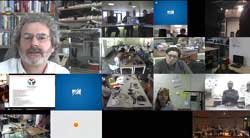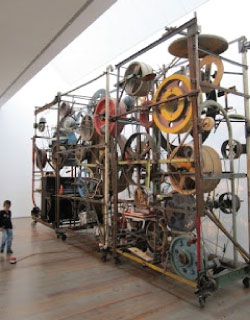W15 ¦ Applications and Implications
Assignment for week 15
- Propose a final project that integrates the range of units covered:
- What will it do?
- Who's done what beforehand?
- What materials and components will be required?
- Where will they come from?
- How much will it cost?
- What parts and systems will be made?
- What processes will be used?
- What tasks need to be completed?
- What questions need to be answered?
- What is the schedule?
- How will it be evaluated?
- Assignment projects can be separate or joint, but need to show individual mastery of all of the skills where possible, you should make rather than buy the parts of your project
- Link to this week’s homeworkpage
1. What will it do?
As a criteria for the final project I started with this description:
- It is a interactive poetry making machine or a short storyteller.
- The storyteller is moving slowly in its regular state but when approached it will change position and form the words that make up the story.
This description was deliberately vague in the beginning because I wanted to be able to explore different ways to achieve this goal. After some brainstorming sessions I found myself drawn to motors.
2. Who's done what beforehand?
As research for my final project I started looking at several things:
- Different ways to display text.
- Lettering installation.
- Kinetic art.
- Who has done what with motors.
The artist Arthur Ganson has always been a major inspiration for me. I was fortunate to work with him on a project here in Iceland few years ago setting up a very large chain reaction instalation with kids. There we were using all kinds of found material, and used methods like water, fire, gravity, motors and even fireworks to keep the reaction going. I love introducing my students to his work as they get just as excited as I do. For my final project I am very much influenced by many of his mechanical sculptures. Here is a link to his website.
As always, I collected my research on a board at Pintrest
I also made couple of playlist on youtube, 1 & 2.
3-5 What materials and components will be required?
4. Where will they come from?
5. How much will it cost?
- Needed for the 30 boards and motors
- 30 Bipolar Stepper Motors - I ordered and paid for 35 motors from Jamico. Price $ 2.29 each or $ 80.15 - They are being processed by customs.
- 30x2 H-Bridges - I ordered and paid for 70 H-Bridges $ 1.57 each or $ 110.7 - estimated delivery Mai 20.
- 30 ATTiny44 microcontrollers - I ordered from DigiKey 35 ATTiny44 $ 1.36 each or $ 47.6 - estimated delivery Mai 20.
- 30 Hall Sensors - I orderd and paid for 35 Hall sensors $ 1.17 each or $ 41 - estimated delivery Mai 20
- 30x2 (2x2) connectors -Buying for Fab Lab Reykjavik
- 30 (2x3) connectors -Buying for Fab Lab Reykjavik
- 30x2 Capacitor 0.1uF -Buying for Fab Lab Reykjavik
- 30 Capacitor 1uF -Buying for Fab Lab Reykjavik
- 30x2 Capacitor 10 uF -Buying for Fab Lab Reykjavik
- 30 Resistor 10K -Buying for Fab Lab Reykjavik
- 1 power cable with 30 connecting shoes -Buying from Fab Lab Reykjavik
- 1 5 volt adapter - Will find one
- 30 connectors on a cable for power for the motors -Buying for Fab Lab Reykjavik
- 1 Communication cable with 30 connecting shoes -Buying for Fab Lab Reykjavik
- 1 serial communication cable - got one
- 1 Computer or RaspberryPi - got one
- 1 webCam - got one
- For the structure:
- Cardboard, paper, MDF and found objects to be used as rapid prototyping materials. These material I already have.
- Since I am still experimenting with materials for the final implementation I am open to all sorts of possibilities, and I am exploring materials like porcelain, stoneware, glass, wood, concrete, plaster, metals, paper and lots more. In my studio I have all except concrete and tin.
- I might 3D print some mechanical prototypes for the supporting structure which I could then use to cast from
6-8. What parts and systems will be made?
7. What processes will be used??
8. What tasks need to be completed?
- The program to control 30 motors, each connected to their own microcontroller:
- The program reads a magnetic sensor (Hall sensor) and uses that for placement. It starts by finding the home position when the machine is turned on. It then knows where it is as long as the power is on.
- The program can be reset with a button
- Each motor program has 40 different positions defined.
- Each board controlling the motors has it's own ID.
- When the program receives a message, it first compare it’s own ID with the one received. If it matches it will act on the order, otherwise it will stay put and ignore the order.
- When the program recognizes its ID being called, it acts on the order and moves to right letter position.
- Motion detections:
- When there is no motion, the poetry machine programs turns slowly, but when approached and it detects motion it comes to a stand still and displays a random poem.
- A webcam detects the motion.
- Using javascript in a web page for the motion detection script.
- Connection between the computer and the motors:
- The boards for the motors are connected together with one cable.
- Communicatiing through the Serial port.
- Using node.js as a websocket server. The web page communicates to the serial port through a javascript bridge placed on the node.js server.
- A delay is defined so the program does not send endless poems if there is constant motion.
- The bridge receives the poem and send the first letter to the first motor, the second letter to the second motor, and so forth.
- Poems picked
- A program picks a poems randomly from a list of predefined poems.
- The program send the poem the the motors.
- The Mechanics -physical implementation
- The boards are milled and made. (only 2 test boards ready)
- The motors are turning some kind of gizmo with letters on it, a wheel, or string of pearls, or some kind of conveyer belt construction.
- The boards are all connected together and communicating on one line.
- All the motors are receiving electricity from a single power line.
- Nice to haves:
- A form on the website where people can add the own sentences/poems
- A set of orders that can be sent from the website to the motors to tweak their position or home position.
- The program can receive a reset order that says: find home again without pressing the button.
- Putting the program onto a Raspberry py insted of the labtop.
9. What questions need to be answered?
- How strong is the motor? What does this translate to in reality: Holding Torque 18.9mN·m, Pull-out Torque 17.4mN·m/400pps, Pull-in Torque: 16.3mN·m/400pps
- What kind of mechanics will work?
- What will look interesting?
10. What is the schedule?
- Mai 20-31 Design exploration.
- From June 1-8. Assembly
- June 8-10. - Final presentation and fine tuning
11. How will it be evaluated?
- For the project to succeed it needs to be a working prototype with at least one motor running and moving to it's positions.








